In the world of industrial maintenance, vibration sensors have become an essential tool. Whether detecting premature wear, mechanical imbalance, or bearing failure, these sensors play a key role in equipment condition monitoring. They help prevent unplanned shutdowns and extend the lifespan of critical machinery.
Among the market leaders, Parker Meggitt offers high-precision vibration detection solutions, used particularly in the energy, transportation, and industrial production sectors.
What is a vibration sensor?
A vibration sensor is a measuring device designed to detect and quantify the oscillatory movements of an object or structure. These movements, called vibrations, are often emitted naturally by rotating machinery such as engines, turbines, pumps, or compressors. When a machine is operating normally, its vibration behavior is stable and predictable. However, any change in the intensity, frequency, or direction of vibrations can indicate the beginning of a mechanical anomaly.
How does a vibration sensor work?
The sensor converts mechanical movement (acceleration, speed, displacement) into a proportional electrical signal. This signal is then analyzed, often using a monitoring system such as the Parker Meggitt VM600, to interpret vibration levels and trigger alarms if necessary.
The physical quantities measured are:
- Acceleration (g or m/s²): used for high frequencies.
- Speed (mm/s or in/s): more commonly used for rotating equipment.
- Displacement (µm or mils): useful for low frequencies.
The different types of vibration sensors
Here are the main types used in industry:
1. Piezoelectric accelerometers
- Widely used for their reliability.
- Sensitive to a wide frequency range.
- Examples: SE120 from Parker Meggitt
2. Speed sensors
- Less sensitive to high frequencies.
- Used for large rotating machines (turbines, alternators).
3. Displacement sensors (proximity)
- Measure axial or radial displacement.
- Used in monitoring critical machinery.

Parker Meggitt's expertise: precision, reliability, durability
The technology developed by Parker Meggitt stands out for its robustness and its ability to provide extremely accurate measurements, even in environments with high mechanical or thermal stress. The SE120 sensor, for example, is designed to offer excellent stability over time while being compatible with centralized diagnostic systems.
When coupled with the VM600 system, the collected data can be analyzed in real time or archived for historical analysis. This makes it possible to track the progress of a fault, prioritize maintenance actions, and secure critical facilities.
Why do call on Normandy Control Group/NCG ?
By contacting Normandy Control Group, you’re choosing a trusted partner for the maintenance and repair of your industrial equipment. As an official Woodward and Parker Meggitt (vibro-meter) distributor in France and French-speaking Africa, particularly in Algeria, Tunisia, and Morocco, we offer recognized expertise in the field. We also have two workshops in France, in Le Havre and Marseille, as well as workshops in Côte d’Ivoire and Senegal.



